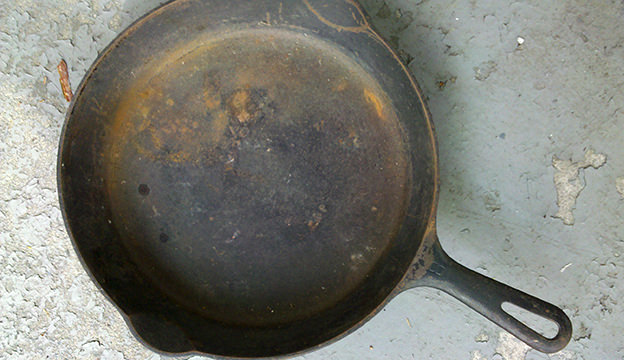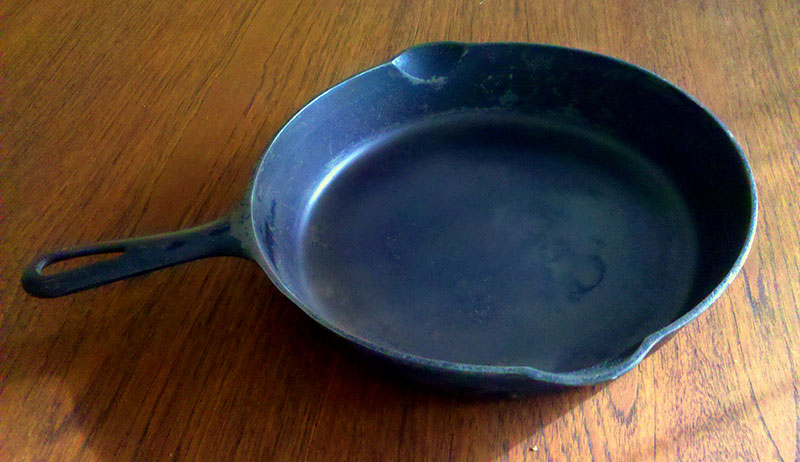
Have you ever dreamed of finding a buried treasure? Many of us have, but the reality is that not too many pirates’ chests are still waiting to be found. However, “treasure” can be defined in many ways. In the farm kitchen, cast iron cookware is treasured by many.
Cast iron pots and pans have been used for hundreds of years; many have been passed down through generations. Today, many people don’t know how properly to care for, clean or refurbish cast iron pots, making it possible for the savvy treasure hunter to find gems just waiting to be returned to use.
Why Choose Cast Iron?
Cast iron cookware is versatile and durable. It can go from stovetop to oven and back again if necessary. It heats evenly and holds the heat well, making it excellent for browning meat or simmering stews and soups. A cast iron griddle will yield fabulous pancakes and French toast. And, with a little bit of care and proper treatment, a cast iron pot’s surface will be as nonstick as modern cookware.
Once you’ve found your rusty, filthy treasure and are ready to begin the restoration process, you need to do some work. Depending on what grimy problems you’re facing, you have several options to refurbish cast iron. (The video below covers the same basic steps as I do here.)
Step 1: Burn Off Baked-On Mess
One of the simplest ways to remove the baked-on, grimy accumulation of gunk from your cast iron pan is to use the self-cleaning cycle of your oven. (Caution: Don’t use this method with wooden handled pans.)
Place the pan upside down on a rack in the oven and run one self-cleaning cycle. After the oven has cooled, you’ll be left with pans coated with fine ash and possibly rust. (Read on for information on how to deal with rust.) As a bonus, you’ll also have a clean oven.
One word of caution: Leaving your oven rack in the oven during the self-cleaning cycle might darken the metal, and the rack might be slightly more difficult to slide in and out.
(Don’t have a self-cleaning oven? That’s OK. Click here for an alternative cast iron cleaning process.)
Step 2: Remove Rust
After cleaning the pan in your oven, soak the pan in a solution of half white vinegar and half water to remove accumulated rust. Find a container that’s big enough to hold the rusty pan and completely submerge it into the solution. Let it soak no longer than one to four hours. The acid in the vinegar will dissolve the rust, but if the rust doesn’t dissolve completely, a plastic scrub brush will loosen stubborn areas.
If you leave the pan in the vinegar solution for too long, the acid will start to dissolve the pan and damage it, so check the condition of the pan often while soaking. The more rust on the cast iron pan, the longer it will need to soak. When you’re satisfied that the rust is gone, protect your hands with rubber gloves, remove the pan from the vinegar solution and rinse thoroughly under running water. Dry with a kitchen towel, then place the pan into an oven set at a low temperature; bake for a few minutes to make sure the pan is completely dry.
Step 3: Oil Up and Season
It’s the nature of cast iron for a faint sheen of rust to form on the surface almost immediately as the pan dries. Use fine sandpaper to remove the light rust, then wipe with a soft rag to remove dust. Using a paper towel, immediately cover the pan with a thin coating of vegetable oil or shortening to prevent rust from returning.
Now that your pan is free of rust and grime, it needs to be seasoned before you can cook with it. To season the pan, coat it with a thin layer of vegetable cooking oil or vegetable shortening. Place the pan upside down on a rack in your 350- to 400-degree-F oven for about 45 minutes. By placing the pan upside down, excess oil will drain off rather than form a gooey pool in the bottom of the pan. Place a cookie sheet lined with aluminum foil on the lower rack of the oven to catch any drips.
As it heats, the oil will flow into nooks and crannies in the pot’s surface, and form a nice, smooth coating. Be sure to apply the oil in a thin layer so it doesn’t pool when it heats.
For the best results, you should repeat this seasoning process three or four times before using your pan to cook. After that, cooking will continue the seasoning process and your pan eventually will develop the nice, smooth, black patina treasured in a well-cared-for cast iron pan.
Step 4: Maintain Cast Iron

A well-seasoned cast iron pot is not difficult to keep clean. After using it, simply rinse under hot water and use a plastic scrub pad or scrub brush to remove any stubborn bits of food. Immediately after washing, dry the pan with a kitchen towel.
To make sure the pan is completely dry, place it on a stove burner turned on low for a few minutes.
Then, while the pan is still warm, carefully coat the inside of the pan very lightly with cooking oil. This will prevent any rust from forming in the nicks you may have made in the surface. Any skillets or Dutch ovens that have lids should be stored uncovered or should have a folded paper towel placed between the pan and the lid to provide air flow. This keeps moisture from building and potentially causing rust. Never store food in a cast iron pot—the acids from the food will damage the seasoning—and never put cast iron in the dishwasher. Here are some additional tips and facts:
- Using cast iron cookware is a good way to add iron to your diet; the food cooked in it will absorb a bit of the mineral.
- Don’t pour cold liquid onto a hot pot. The sudden temperature change could cause the pan to crack.
- Always keep thick potholders handy. You cannot handle a hot pot’s handle without them.
- Never soak your pan in water.
It’s not difficult to restore cast iron cookware, and once restored, maintenance is simple. So if you are not already cooking with cast iron, go on your own treasure hunt.
Rust or caked-on, rancid grime are reasons many perfectly good cast iron pots and pans have been shoved to the back of kitchen cabinets, buried in boxes in a basement, or stored in piles of junk in the corner of a barn. If you don’t have your own pot that’s awaiting your attention, ask your relatives and friends what they have tucked away. If those avenues fail, try yard sales, barn sales or flea markets to find inexpensive pots and pans in need of refurbishing.
eBay and Craigslist are also good resources for finding old cast iron cookware, but be careful: Only look at local listings. Cast iron is heavy and shipping costs can quickly turn a bargain into an expensive project. Persevere: It will be worth the search. A little time and effort spent refurbishing a pan will yield a treasured piece of cookware that will provide years of service for you, your children and even your grandchildren.
To learn more about cast iron, see Hobby Farms stories including 8 Foods That Taste Better in Cast Iron, 3 Recipes that Flaunt Cast Iron’s Versatility, and 4 Cast Iron Kitchen Accessories.




